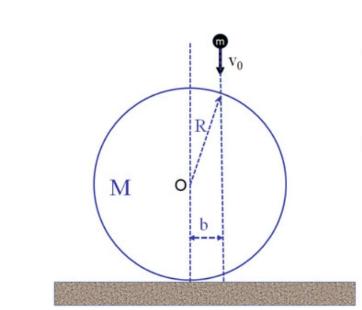A disk of mass (M=470 mathrm{~g}) and radius (R=15 mathrm{~cm}) rolls without crawling on a horizontal plane.
Question:
A disk of mass \(M=470 \mathrm{~g}\) and radius \(R=15 \mathrm{~cm}\) rolls without crawling on a horizontal plane. A point mass \(m=240 \mathrm{~g}\) impacts on it and remains attached, Fig. 12.13. At the instant immediately preceding the impact, the velocity of the mass \(m\) is vertical and \(v_{0}=25\) \(\mathrm{m} / \mathrm{s}\) in magnitude. The projection of the impact point on the horizontal support plane is at a distance \(b=5 \mathrm{~cm}\) from the origin \(\mathrm{O}\).
1. After a certain time, the mass \(m\) comes into contact with the support plane at a point \(\mathrm{O}^{\prime}\). Determine the distance between \(\mathrm{O}^{\prime}\) and \(\mathrm{O}\).
2. Determine the moment of inertia of the system with respect to the origin \(\mathrm{O}\) immediately after the collision.
3. Determine the angular speed \(\omega\) of the disk+mass system immediately after the collision.
4. Determine the angular speed \(\omega^{\prime}\) of the system when the mass \(m\) comes into contact with the supporting plane.
Fig. 12.13

Step by Step Answer:






